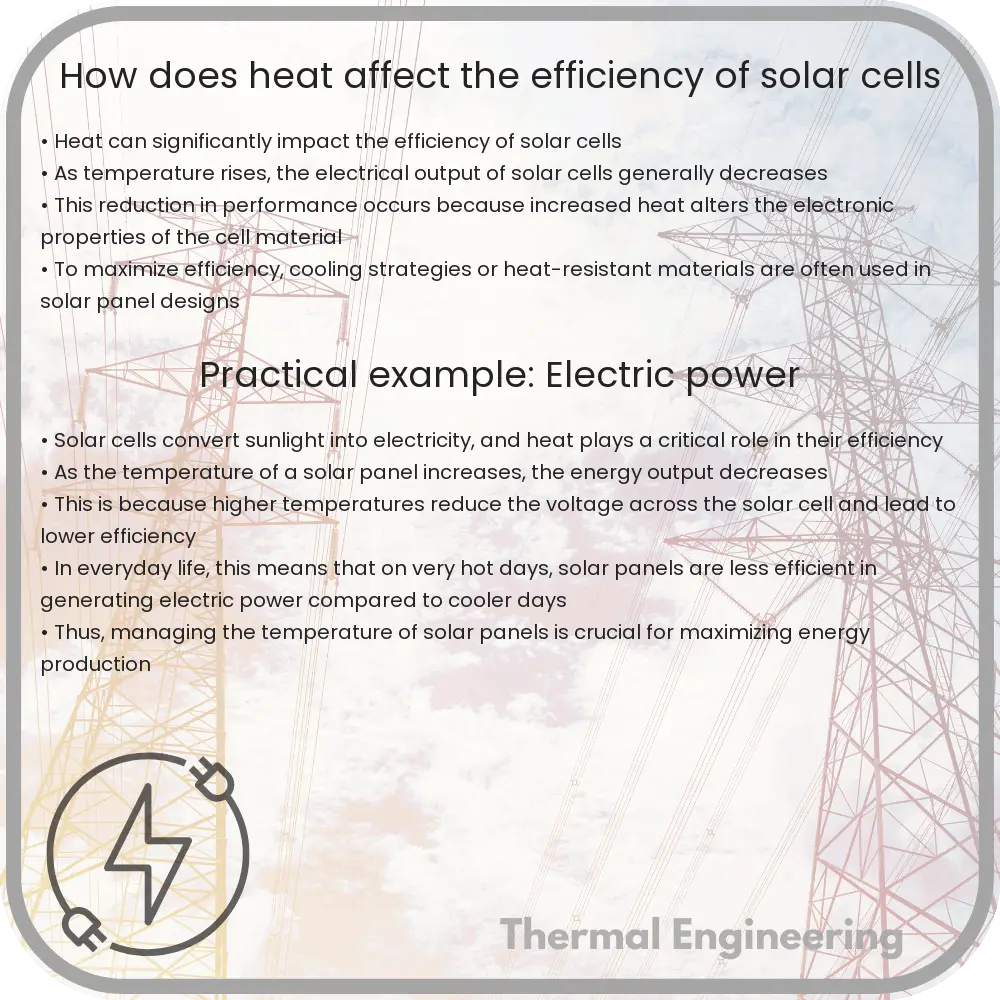This article examines how temperature variations impact the efficiency and performance of solar cells in solar energy systems.

Understanding the Impact of Temperature on Solar Cell Efficiency
Solar cells, which convert sunlight into electricity, are a key technology in harnessing solar energy. However, the efficiency of these cells is significantly influenced by various factors, including temperature. Generally, as temperatures rise, the efficiency of solar cells declines, impacting their overall performance. This article explores how and why this thermal effect occurs and what it means for solar energy applications.
How Temperature Affects Solar Cell Performance
Solar cells are designed to absorb sunlight and convert it into electricity, but their operational environment can vastly affect their efficiency. Temperature plays a crucial role in the photovoltaic (PV) process, and understanding this can help in maximizing the effectiveness of solar installations.
- Reduction in Voltage: As the temperature of a solar cell increases, the output voltage decreases. This inverse relationship stems from the inherent properties of the semiconductor materials used in solar cells. An increase in temperature leads to an increase in the kinetic energy of the electrons, which in turn reduces the bandgap of the semiconductor.
- Decrease in Efficiency: The overall conversion efficiency of a solar cell also decreases with temperature. Efficiency is a measure of how well a solar cell can convert sunlight into electricity, expressed as a percentage. The reduction in voltage and potential power loss at higher temperatures directly affects this efficiency.
Understanding the efficiency behavior of a solar cell relative to temperature starts with examining the temperature coefficient, which quantifies how the performance of a solar cell changes with temperature. This coefficient varies depending on the material composition of the solar cell (e.g., silicon, thin-film). Typical values range from -0.20% /°C to -0.50% /°C for crystalline silicon PV cells.
Thermal Coefficients and Their Significance
Key metrics that describe how the properties of solar cells change with temperature include:
- Temperature Coefficient of Voltage (αV): This coefficient measures the change in output voltage with a change in temperature. It is typically negative for most types of solar cells, meaning that as temperature increases, output voltage decreases.
- Temperature Coefficient of Current (αI): Unlike the voltage, the current has a positive temperature coefficient, indicating minor increases in current as temperature rises. However, this slight increase is not enough to offset the decrease in voltage and overall power output.
- Temperature Coefficient of Power (αP): This is the most critical factor as it combines the effects of changes in both voltage and current. It gives a comprehensive picture of how power output from a solar cell changes with temperature. Generally, this coefficient is negative, indicating a decrease in power output as the temperature increases.
Practical Implications and Mitigation Strategies
The decrease in solar cell efficiency with increasing temperature has practical implications for the deployment and operation of solar power systems, particularly in hot climates. To cope with these challenges, several strategies can be employed:
- Proper Ventilation and Cooling Systems: Ensuring adequate airflow around solar panels can help reduce temperature and maintain higher efficiency.
- Selection of Appropriate Materials: Using materials with better thermal coefficients when designing solar cells and panels can minimize efficiency losses due to heat.
- Integration with Building Design: Fusion of solar cells with building materials that reflect away some of the sun’s heat can reduce temperature-induced efficiency losses.
In conclusion, while solar cells are promising tools for sustainable energy, their efficiency is significantly influenced by temperature. Understanding and mitigating the negative effects of high temperatures is essential for optimizing their performance and longevity. Through strategic design and deployment, the impact of temperature on solar cells can be managed to ensure they deliver maximum power output, regardless of their operating environment.